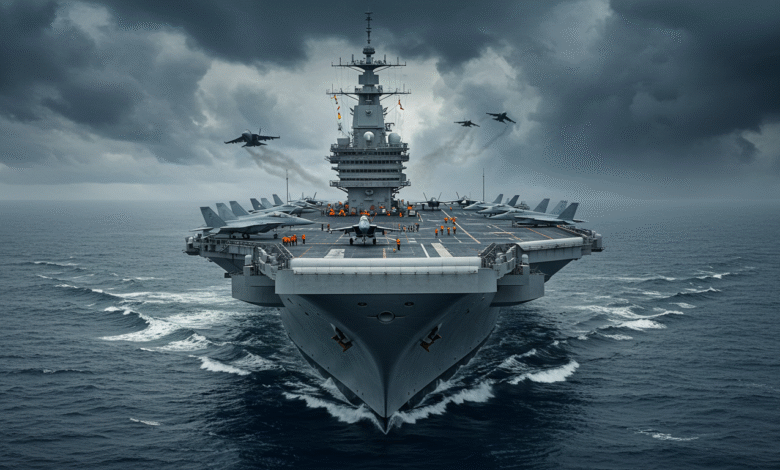Navy Thwarted Indian Aircraft Carrier Threat, Says Shehbaz

Introduction
In a dramatic revelation that has stirred defense circles and diplomatic quarters alike, Prime Minister Shehbaz Sharif has claimed that the Pakistan Navy successfully thwarted a major threat posed by an Indian aircraft carrier. This assertion, made during a high-level defense briefing, underscores the growing tensions in the Indian Ocean region and highlights the strategic importance of Pakistan’s maritime forces.You know about theglobespot, andaazdaily, openrendz and indian aircraft carrier threat also Buzzfeed.
The statement, while bold, serves to boost national morale and reinforces Pakistan’s commitment to regional stability and security. But what exactly happened, and what are the broader implications?
The Backdrop: Rising Tensions in the Indian Ocean
The Indian Ocean has been a hotspot for strategic power plays. Both India and Pakistan, nuclear-armed neighbors with a history of conflict, have been increasing their naval capabilities. India’s aircraft carriers symbolize its blue-water navy ambitions, while Pakistan has focused on agility, precision, and deterrence.
In recent months, intelligence suggested unusual movement by Indian naval assets near international waters close to Pakistan’s Exclusive Economic Zone (EEZ). While India claimed routine exercises, Pakistan’s defense apparatus interpreted the presence as a provocative display of force.
The Prime Minister’s Statement: What Shehbaz Said
Addressing a joint session of Parliament, Prime Minister Shehbaz Sharif stated:
“Our brave naval forces remained vigilant. They tracked the Indian aircraft carrier, assessed the threat, and took the necessary steps to ensure it never breached our defensive threshold.”
The Prime Minister lauded the Navy’s “quick decision-making and operational readiness,” emphasizing that no aggressive posture would be tolerated in Pakistan’s maritime domain.
Operational Readiness: Inside Pakistan Navy’s Rapid Response
The Pakistan Navy has maintained a doctrine of strategic deterrence, emphasizing readiness and rapid response. When the Indian aircraft carrier entered sensitive waters, Pakistan’s naval command activated several protocols:
-
Deployment of submarines for stealth surveillance.
-
Use of maritime patrol aircraft to shadow the vessel.
-
Live communication with the fleet to coordinate real-time strategy.
These measures ensured the Indian vessel stayed well outside Pakistan’s territorial boundaries, thus averting a potentially dangerous escalation.
How the Navy Detected the Threat
Thanks to advanced radar and satellite surveillance, the Navy identified the Indian aircraft carrier well before it posed a direct risk. Sources confirm that P-3C Orion and Sea King helicopters played a critical role in surveillance and early threat detection.
By maintaining communication with regional allies and maritime monitoring systems, the Navy ensured a coordinated and informed response.
Role of Submarines: The Silent Guardians
Pakistan’s submarines are its most potent maritime asset. These diesel-electric and AIP-powered subs are designed for stealth and precision. During this episode, several subs tracked the Indian carrier’s movements without detection, providing real-time updates to naval command.
This silent shadowing created a psychological deterrent and demonstrated Pakistan’s undersea capabilities.
Electronic Warfare and Cyber Defense
Modern naval warfare isn’t only about firepower. It’s also about information dominance. Pakistan employed electronic countermeasures to jam or intercept communications from the Indian fleet. Cyber defense teams worked round the clock to neutralize any potential cyber threats targeting Pakistan’s naval command systems.
This combination of digital and physical defense prevented any security breach or surprise maneuver.
India’s Stand: Routine Exercise or Provocation?
The Indian Ministry of Defence downplayed the situation, calling it part of a “scheduled maritime exercise.” However, defense analysts question the timing and location of the deployment. The proximity to Pakistan’s maritime boundaries, especially during a time of political instability in South Asia, has led to speculations of intentional posturing.
Regional Reactions: What Other Countries Are Saying
China, Turkey, and Iran have issued statements supporting maritime peace. Meanwhile, the United States and the UK urged both nations to maintain open communication and avoid miscalculations.
International watchdogs have started closely monitoring naval movements in the Arabian Sea, hinting that any future tension could affect trade routes and energy supplies.
Impact on Maritime Trade and the CPEC Route
The China-Pakistan Economic Corridor (CPEC), a key part of the Belt and Road Initiative (BRI), relies heavily on maritime stability. Any threat from an Indian aircraft carrier in the Arabian Sea directly jeopardizes shipping lanes leading to Gwadar Port.
Shehbaz Sharif stressed that the Pakistan Navy is “fully capable of protecting CPEC’s maritime component.”
Public Sentiment and National Unity
The revelation has galvanized public support for the armed forces. Social media platforms have been flooded with hashtags like #PakNavyDefended, #ShehbazOnGuard, and #IndianThreatNeutralized. Citizens have shown increased confidence in the country’s defense capabilities, and several rallies have been held in support of the Navy.
Opposition’s Take: Political or Practical?
Opposition parties in Pakistan have raised concerns about politicizing defense matters. While they praised the Navy’s actions, they warned against using such incidents to distract from domestic economic issues.
However, most agreed that maintaining vigilance along maritime borders is a non-negotiable matter of national interest.
Comparison of Naval Power: India vs Pakistan
While India boasts a larger navy with multiple aircraft carriers and destroyers, Pakistan emphasizes agility, technological edge, and focused deployment. Let’s compare:
| Metric | India | Pakistan |
|---|---|---|
| Aircraft Carriers | 2 operational | None (focus on subs & fast craft) |
| Submarines | 16+ (nuclear and diesel) | 8 (diesel-electric, AIP-equipped) |
| Naval Budget | $7.5 billion+ | $1.2 billion+ |
| Naval Bases | 13+ major bases | 4 major bases |
Despite the disparity in size, Pakistan’s Navy relies on asymmetric warfare tactics and smart defense technologies.
Strategic Depth and Future Preparations
The Navy has now increased its patrolling frequency and widened surveillance grids. Exercises like Seaspark and AMAN are expected to intensify, involving regional partners to showcase strength and unity.
Shehbaz has also hinted at acquiring new platforms and expanding the submarine fleet to enhance deterrence capabilities.
International Law and Maritime Rights
Pakistan’s claim rests on UNCLOS (United Nations Convention on the Law of the Sea). According to maritime law, countries must respect EEZs and international water norms. Any aggressive maneuver near Pakistan’s EEZ could be deemed a violation.
Legal experts argue that if India intended to provoke, it could be held accountable under international maritime law.
Lessons Learned and Way Forward
-
Preparedness Pays Off: Constant vigilance saved the day.
-
Deterrence Is Key: A strong posture avoids conflict.
-
Alliances Matter: Information-sharing with allies ensured accurate threat analysis.
-
Public Trust Strengthens Defense: Unity behind the armed forces boosts morale.
Conclusion
Prime Minister Shehbaz Sharif’s statement about thwarting the Indian aircraft carrier threat is not just a political claim; it reflects Pakistan’s evolving defense doctrine. In an age where battles are fought as much with technology and information as with weapons, Pakistan’s Navy has shown it can rise to the occasion.
The Indian Ocean may remain tense, but one thing is clear: Pakistan will not back down when its sovereignty is tested. The Navy’s actions serve as a message—not just to India, but to the world—that maritime defense is a pillar of national pride and security.



